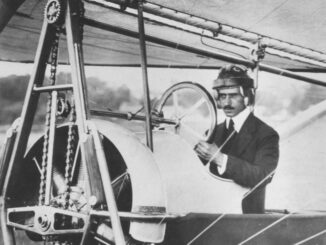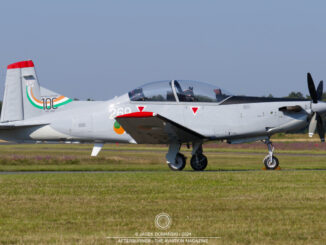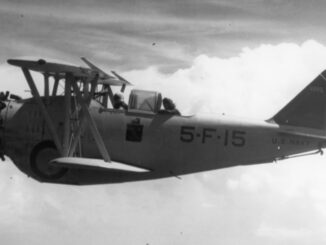 On 30th May 1944, the Swiss-developed SB-2 Pelikan (English: pelican) light transport aircraft, performed its maiden flight.
On 30th May 1944, the Swiss-developed SB-2 Pelikan (English: pelican) light transport aircraft, performed its maiden flight.
In 1938, the then Swiss Eidgenössisches Luftamt (Federal Aviation Office) launched the programme of new light transport aircraft, able to operate from short Alpine airfields. Development of the aeroplane was assigned to newly established Studienbüro für Spezialflugzeuge (Study Office for Special Aircraft), organised at ETH Zürich (Eidgenössische Technische Hochschule Zürich – Federal Institute of Technology Zurich) technical university.
The project developed by the aforementioned construction bureau was a four-seat, single-engine STOL experimental aircraft, designated SB-1. The aeroplane was characterised by unorthodox drive solution – the SB-1 had to be powered by single Argus eight-cylinder inline engine which, through belts and idlers, would drive two propellers mounted on the wing edges (as used with conventional twin-engine aircraft).
Although interesting, the SB-1 programme never went beyond the project stage. Some of its elements were tested at the ETH but no prototypes were completed. Shortly after, the development was finally abandoned.
In December of 1939, at the time when development of the SB aircraft still continued, Antoine Gazda and Emil Bührle founded the new Swiss aviation enterprise, Pilatus Flugzeugwerke AG. The main idea behind establishing the company was to develop and manufacture new aircraft. Initially, however, Pilatus provided maintenance and repair services for the country´s armed forces and came up with assembly of EKW-35 biplanes.
In 1940, works on the first Pilatus aircraft, designated P-1, were launched at the company. It, most probably, had to be a single-engine and single-seat training aeroplane but the project never went beyond the initial design stage. The aircraft is known only from being mentioned in the company correspondence from 1941 and the two sketches attached to that letter. Technical specification of the P-1 is still a subject for several speculations and, more or less successful, attempts to recreate the design. Nevertheless, it seems the detailed characteristics of the P-1 disappeared in the shadows of history for ever.
In November of 1940, Studienbüro für Spezialflugzeuge came with another proposal of light utility aircraft with STOL capabilities, designated SB-2 Pelikan. The second project was based on more conventional construction of a high-wing, single-engine aircraft, however it implemented a few technical novelties, such as fixed tricycle landing gear and forward-swept wing. The aeroplane was powered by nine-cylinder, air-cooled Pratt & Whitney R-985 Wasp Junior TB radial engine and could carry up to five passengers plus pilot.
In February of next year, the project was approved by the federal aviation authority and construction of the prototype was assigned to the aforementioned Pilatus company. At that time, the newly established aviation manufacturer was eager to begin with development of its first aeroplane and, initially, the Pelikan project felt propitious. Especially when the P-1 project, mentioned above, did not lead to any results.
However, from the very beginning, the SB-2 project suffered from insufficient funding – as the Swiss government was reluctant to transfer resources to private company – and unrealistic expectations relating its performance. Works on the prototype lasted three years and finally, on 30th May 1944, the SB-2 performed its maiden flight.
The prototype of the SB-2 Pelikan underwent a series of flight tests and then was sold to Alpar AG, which used it for passenger flights until 1948. In June of that year, the aeroplane participated in an air show where it performed from an improvised airstrip and was damaged at landing.
Although initially the Alpar company wanted to repair the aeroplane, and there were even ideas to re-build the SB-2 into bigger aircraft, able to carry up to seven passengers, it all ended with lack of financial resources. The Pilatus company rejected all proposals to work on the Pelikan repairs, considering them unrealistic and still bearing in mind the financial loss it suffered while working on the prototype. Moreover, the company was now focused on manufacturing its own aircraft, Pilatus P-2 trainer for the Swiss Air Force.
Eventually, in March of 1949, the SB-2 was removed from the Swiss aircraft register.
After completing the design of the SB-2, Studienbüro für Spezialflugzeuge continued its works on further projects of the so-called Schweizer Bergflugzeug (Swiss mountain aircraft). The final development of that construction bureau was designated SB-5 and was an enlarged variant of the Pelikan, able to carry up to nine passengers and pilot. Regrettably, there is no evidence proving any existence of potential SB-3 and SB-4 projects.
In January of 1944, Studienbüro für Spezialflugzeuge was incorporated into newly established Schweizerische Flugtechnische Verein (Swiss Aeronautical Association). Works on the SB-5 programme were finally abandoned within a year, when the aircraft was still in the design phase.
Cover photo: Pilatus SB-2 Pelikan, ETH Library Zurich, Image Archive / Ans_05035-489, Public Domain



